On your next visit to our American galleries you’ll see more than sixty new works on view, including thirty-five objects that are on our walls for the first time, with some of those being recent acquisitions.
Here are some highlights among our most recent acquisitions, which are currently on view and support the Museum’s goal of increasing representation of artists of diverse backgrounds and experiences.
Beatriz Milhazes’s Figo
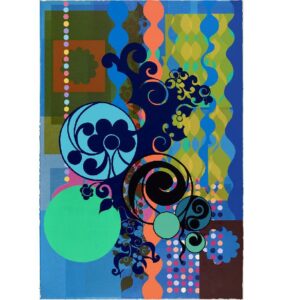
Beatriz Milhazes (Brazilian, 1960), Figo, 2007, Woodblock and screen print on Hiromi handmade Kozo triple thick paper. Allentown Art Museum: purchase: SOTA Print Fund, in Memory of First SOTA President Rusty Young, 2022.
In her vibrant and dynamic artworks, Beatriz Milhazes builds upon European and Brazilian Modernism (Antropofagia) as well as Baroque art, creating a unique language of color and form. Figo’s multilayered relief-printed surface contributes to its compositional energy. The print required an incredible 109 runs through the printing press. It features screen-printed and block-printed colors—some added with found Indian textile-printing blocks—as well as blind embossing, which adds texture but not color.
Figo, with its combination of florid and geometric forms suggesting lush foliage and flashing lights, may evoke Milhazes’s native Rio de Janeiro.
Prior to entering the Museum collection, an impression of this print was on view in Color & Complexity: 30 Years at Durham Press. This work was purchased with the Society of the Arts Print Fund in 2022 in memory of the first SOTA president, Rusty Young.
Keith Haring’s Retrospect
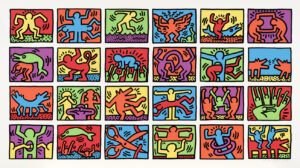
Keith Haring (American, 1958-1990), Retrospect, 1989, screen print. Allentown Art Museum: Gift of Kay Haring, 2022.
One of the most famous and beloved artists and activists of the 1980s, Keith Haring grew up in nearby Kutztown, Pennsylvania, where he learned basic cartooning skills from his father. In 1980 Haring gained international attention by making chalk drawings in the subways of New York City. He sought to create a truly public art in a new language that could be understood by all, thus linking street graffiti to the traditional art world. Haring’s work reveals both positive and negative aspects of life: innocence, love, and friendship as well as anxiety, bigotry, and violence.
Haring was diagnosed with AIDS in 1988. Believing in the power of art to change lives for the better, he poured himself into his work and produced radiant images of birth and life until he died two years later at the age of thirty-one. Retrospect brings together many of his most iconic images. At lower right you can see that the artist inscribed this impression for his sister Kay, who recently donated it to the Museum.
Prior to entering the Museum’s collection, this work was on view in Butz Gallery in 2020 to coincide with Color & Complexity: 30 Years at Durham Press, loaned by Kay A. Haring.
Siona Benjamin’s Finding Home #55: Menorah and Finding Home #70: Rachel
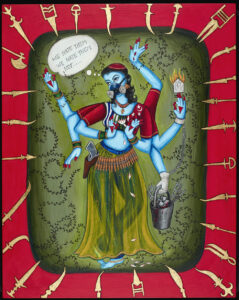
Siona Benjamin, (American, b. India, 1960) Finding Home #55: Menorah, 2002, gouache on wood. Allentown Art Museum: Gift of Francie Bishop Good and David Horvitz, 2021.
Siona Benjamin’s works mix varied religious and cultural symbols; for instance, the blue skin associated with Krishna and other Hindu deities, a red kippah (a Jewish head covering), elaborate borders that evoke Islamic miniature paintings, and jeans paired with South Asian garments. Such hybrid symbols relate to the artist’s experiences growing up Jewish in India, where most people are Hindu or Muslim, and as an immigrant to the United States.
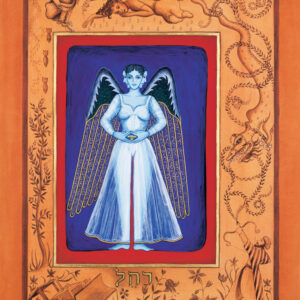
Siona Benjamin, Finding Home #70: Rachel, 2005, gouache on paper. Allentown Art Museum: Gift of Francie Bishop Good and David Horvitz, 2021.
Benjamin also incorporates imagery of violence and trauma in these works, referencing the harm caused by focusing on difference instead of our shared humanity.
These works are the gift of Francie Bishop Good and David Horvitz, and this is the first time the Museum has shown the art of Benjamin.
Romare Bearden’s The Piano Lesson (Homage to Mary Lou)
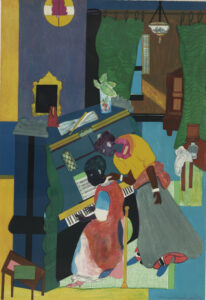
Romare Bearden (American, 1911 1988), The Piano Lesson (Homage to Mary Lou), 1984, lithograph. Allentown Art Museum: purchase, gift of Paul K. Kania, 2023. (2023.10)
Romare Bearden was born in Charlotte, North Carolina, in 1911. His family moved to New York City shortly after, but he continued to spend summers in Mecklenburg County with his grandparents until 1925. The Piano Lesson is part of a series of works that draw inspiration from childhood memories of growing up in the rural South.
Music is a focal point in much of Bearden’s work. Growing up in Harlem he was immersed in the artistic, intellectual, political, and cultural mainstream of the Harlem Renaissance, including the ever-growing jazz music scene. For many years he owned an art studio above Harlem’s world-famous Apollo Theater, where he often heard live jazz and blues music and met numerous musicians. The Piano Lesson displays the importance of music through imagery and subject matter, but the connections do not stop there. Bearden is also paying homage to Mary Lou Williams, an influential jazz pianist, and references the improvisation that is a focal point of jazz and blues music through his own artistic process.
The purchase of Bearden’s lithograph was generously supported by Paul K. Kania in 2023. This is the first time this work is on display at the AAM.

